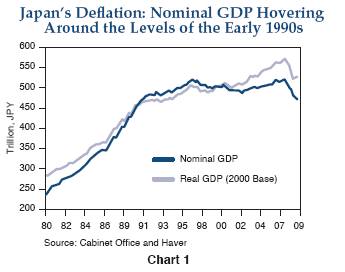
With global growth accelerating in the second half of 2009, policymakers and investors alike naturally turned to discussion and debate regarding central bank exit strategies from the extraordinary, conventional (near-zero policy rates) and unconventional (Quantitative/Credit Easing) accommodation needed to prevent the Great Recession from turning into Depression 2.0. Two key questions dominate: the how of exits and the when of exits.
The Federal Reserve has been exceedingly careful to distinguish between these two questions, providing detailed public discussion of the mechanics of exit, while stressing that economic fundamentals, notably below-target inflation in the context of huge resource slack, particularly labor markets, imply there is no urgent need to implement any exit for an extended period. Other central banks have provided similar guidance, with one major exception, the Bank of Japan (BoJ). And the reason is simple: Japan remains stuck in a deflationary liquidity trap, implying that not only would it be fundamentally wrong for the Bank of Japan to pull back from extraordinary accommodation, but that it should be even more extraordinary.
Thus, we were pleasantly surprised in December that the Bank of Japan publically acknowledged that it would “not tolerate a year-on-year rate of change in the CPI equal to or below 0 percent.” The BoJ’s path to anti-deflation redemption must start somewhere, and simply stating that its comfort zone for inflation does not include zero is a start. The fact of the matter is that the BoJ is trapped in a deflationary lacuna of its own making and can escape if it is willing to do the opposite of what central banks in other developed countries will eventually do in the matter of exit strategies. Simply put, the Bank of Japan needs to credibly commit to not exiting reflationary policies, even as other central banks proceed along that course.
Japan’s Liquidity Trap
An economy enters a liquidity trap when the monetary policy rate is pinned against zero, yet aggregate demand consistently falls short of aggregate supply potential. Such a state of affairs generates enduring economic slack, which in turn generates enduring deflation. That was a very real global risk a year ago, but was met head-on by BoJ’s sister central banks, in particular the Federal Reserve, whose mantra was “whatever it takes.” And while a relapse toward the fat tail risk of global deflationary pressures certainly still exists, that tail has been dramatically flattened by innovative, courageous, and explicitly reflationary policies. Not so for Japan, unfortunately: The country has been in a liquidity trap for almost two decades, with nominal GDP hovering near the levels of the early 1990s. And with a current output gap of 7–8% of its GDP, Japan faces perpetual deflation, unless and until the BoJ walks the reflationary walk.
To be sure, there are many, particularly in high-level policy positions in Japan, who argue that there is nothing more reflationary the BoJ can do, because the country’s liquidity trap is not a temporary one but rather a permanent one. The irony of the argument is that if it is followed, it is guaranteed to be “right,” or at least appear that way, as deflationary expectations remain entrenched and self-feeding. Yes, we recognize that Japan faces unique structural problems, most notably declining demographic growth. But neither in theory nor in practice does such a problem pre-ordain a permanent liquidity trap. It can be broken, if the BoJ were to become willing, in the famous words of Professor Krugman, to act responsibly irresponsible relative to monetary policy orthodoxy.
Conventional wisdom holds that the most effective way to break a liquidity trap is with fiscal policy, levering up and risking up the sovereign’s balance sheet to support aggregate demand, when the private sector is delevering and de-risking. In general, we have no quarrel with that. But what holds in general does not necessarily hold in specific countries. And Japan is indeed an exception, because the central bank uniquely has the ability to foster rising inflationary expectations, lower real long-term interest rates, and a lower real exchange value for the yen, all keys to breaking out of her liquidity trap. Yes, fiscal authorities in Japan can lever the sovereign’s balance sheet in a fashion that would make Keynes blush, but unless the monetary authority rejects orthodoxy, explicitly promising not to exit from reflationary policy, fiscal authorities’ stimulative efforts will be muted.
Krugman/Bernanke’s PrescriptionsFootnote1
Bank of Japan officials suggest that there is not much monetary policy can do, as evidenced by these comments in the minutes of its policy meeting on November 19–20Footnote2 (our emphasis):
To be sure, there are indeed structural solutions besides resolutely reflationary monetary policy that would be helpful. For example, supply-side measures including increased immigration and child care facilities would be very helpful to mitigate Japan’s demographic trend. Likewise, a more flexible labor system would allow corporations to more quickly adjust employment to the levels sustainable in the New Normal, and allow them to invest for new opportunities emerging in Asia. Concurrently, accelerating Economic Partnership Agreements (EPA) would allow Japan Inc. to further benefit from Asia’s economic growth and to remain competitive. And the list goes on and on. So the BoJ does have a point: There needs to be many hands on the policy tiller.
But none of the non-monetary actions offers scope for what matters most: Breaking the private sector’s self-feeding deflationary expectations, while generating aggregate demand above the economy’s supply-side potential, lowering the output gap. Indeed, some desirable supply-side structural reforms would, on a cyclical horizon, actually increase the output gap. The unavoidable conclusion must be that reflationary monetary policy must be the workhorse to pull Japan out of its liquidity trap. For such an approach to be effective, it explicitly must not have an exit strategy, but the opposite: a promise to keep on keeping on, resisting all entreaties to pull back until inflation itself, not just inflationary expectations, is unleashed on the upside.
To its credit, the BoJ did adopt a commitment approach when it adopted Quantitative Easing (QE) in 2001, explicitly committing to a continuation of that regime until year-on-year change in the core CPI became positive in a “stable” manner. But when for a few months it appeared that “success” had been achieved in 2006, the BoJ exited QE. Whether or not it was a matter of a genuine policy mistake, made with the best intentions, or a policy mistake borne of a lack of will to be enduringly unorthodox is an open question. But the fact of the matter is that Japan slipped back into deflation soon thereafter. The missing ingredient was a commitment to not only resist pulling back from QE and avoiding rate hikes until inflation turned positive but to continue that policy even after inflation started moving up. And in terms of credibility, the cost has been high: Unless and until the BoJ commits credibly, backed by money-printing actions, to behaving “irresponsibly relative to orthodox, conventional thinking,” Japan will remain stuck in a liquidity trap.
If the BoJ needs academic footing to do what needs to be done, it could well follow then-Fed Governor Bernanke’s 2003 suggestion: Rather than targeting the inflation rate, the BoJ could target restoring the pre-deflation price level, meaning that deflationary sins are not forgiven. This way, Mr. Bernanke argued, the public would view reflationary increases in the BoJ’s balance sheet and the money stock as permanent, rather than something to be “taken back” at the earliest orthodox opportunity.
The BoJ: Time to Act Aggressively
Japan’s problem is deflation, not inflation as far as an eye can see. An “all-in” reflationary policy is what is needed.
Three concepts the BoJ could consider:
- Explicitly promise there will be no exit from QE and no rate hikes until inflation is not just positive, but meaningfully positive. One way to do this would be to adopt a price level target rather than an inflation target, embracing the idea that past deflationary sins will not only not be forgiven but require even more aggressive reflationary atonement.
- Buy unlimited amounts of the long-dated Japanese Government Bonds (JGBs) to pull down nominal yields, with an accord with the fiscal authority to absorb any future losses on JGBs, once reflationary policy has borne its fruits, generating a bear market in JGBs.
- Working with the Ministry of Finance, sell unlimited amounts of Yen against other developed countries’ currencies, printing the necessary Yen.
Our read is that the BoJ has not concluded that such bold steps are required. But as Mr. Bernanke intoned,Footnote3 no country with a fiat currency, which borrows in its own currency in the context of a current account deficit, should ever willingly embrace deflation. It is to be fervently hoped that the Bank of Japan’s rhetorical reflationary thaw of December, declaring it will not “tolerate” zero or below inflation, will give way to active reflationary green shoots by spring.
Meanwhile, markets don’t wait. And if it becomes clear that the BoJ really does “get it,” the currency markets will be way out in front of the BoJ.
Paul McCulley
Managing Director
mcculley@pimco.com
Tomoya Masanao
Executive Vice President
masanao@pimco.com
January 4, 2010
1 Paul McCulley, Global Central Bank Focus: “What If?” (July 2009) Return to content
2 Bank of Japan, Minutes of the Monetary Policy Meeting on November 19 and 20, 2009 Return to content
3 Ben Bernanke, “Deflation: Making Sure ‘It’ Doesn’t Happen Here” Return to content

